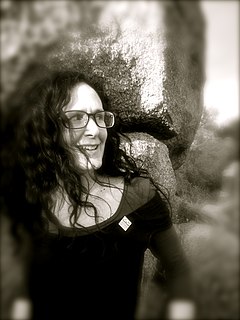Related Research Articles

An electronic musical instrument is a musical instrument that produces sound using electronic circuitry. Such an instrument sounds by outputting an electrical, electronic or digital audio signal that ultimately is plugged into a power amplifier which drives a loudspeaker, creating the sound heard by the performer and listener.

A sound card is an internal expansion card that provides input and output of audio signals to and from a computer under control of computer programs. The term sound card is also applied to external audio interfaces used for professional audio applications.

Digital music technology encompasses digital instruments, computers, electronic effects units, software, or digital audio equipment by a performer, composer, sound engineer, DJ, or record producer to produce, perform or record music. The term refers to electronic devices, instruments, computer hardware, and software used in performance, playback, recording, composition, mixing, analysis, and editing of music.
A music sequencer is a device or application software that can record, edit, or play back music, by handling note and performance information in several forms, typically CV/Gate, MIDI, or Open Sound Control (OSC), and possibly audio and automation data for DAWs and plug-ins.
Modular synthesizers are synthesizers composed of separate modules of different functions. The modules can be connected together with patch cords, a matrix patching system, or switches by the user to create a patch. The output (voltages) from the modules may function as (audio) signals, control voltages, or logic/timing conditions. Typical modules are oscillators, filters (spectrum), amplifiers/gates (amplitude) and Envelope generators.

A digital audio workstation (DAW) is an electronic device or application software used for recording, editing and producing audio files. DAWs come in a wide variety of configurations from a single software program on a laptop, to an integrated stand-alone unit, all the way to a highly complex configuration of numerous components controlled by a central computer. Regardless of configuration, modern DAWs have a central interface that allows the user to alter and mix multiple recordings and tracks into a final produced piece.

Max, also known as Max/MSP/Jitter, is a visual programming language for music and multimedia developed and maintained by San Francisco-based software company Cycling '74. Over its more than thirty-year history, it has been used by composers, performers, software designers, researchers, and artists to create recordings, performances, and installations.

Pure Data (Pd) is a visual programming language developed by Miller Puckette in the 1990s for creating interactive computer music and multimedia works. While Puckette is the main author of the program, Pd is an open-source project with a large developer base working on new extensions. It is released under a license similar to the BSD license. It runs on GNU/Linux, Mac OS X, iOS, Android and Windows. Ports exist for FreeBSD and IRIX.

The Continuum Fingerboard or Haken Continuum is a music performance controller and synthesizer developed by Lippold Haken, a professor of Electrical and Computer Engineering at the University of Illinois, and sold by Haken Audio, located in Champaign, Illinois.
FAUST is a domain-specific purely functional programming language for implementing signal processing algorithms in the form of libraries, audio plug-ins, or standalone applications. A FAUST program denotes a signal processor: a mathematical function that is applied to some input signal and then fed out.
Symbolic Sound Corporation was founded by Carla Scaletti and Kurt J. Hebel in 1989 as a spinoff of the CERL Sound Group at the Computer-based Education Research Laboratory of the University of Illinois at Urbana–Champaign. Originally named Kymatics, the company was incorporated as Symbolic Sound Corporation in March 1990. Symbolic Sound's products are being used in sound design for music, film, advertising, television, speech and hearing research, computer games, and other virtual environments. The company is based in Bozeman, Montana.
AudioMulch is modular audio software for making music and processing sound. The software can synthesize sound and process live and pre-recorded sound in real-time.

A synthesizer is an electronic musical instrument that generates audio signals. Synthesizers generate audio through methods including subtractive synthesis, additive synthesis, and frequency modulation synthesis. These sounds may be shaped and modulated by components such as filters, envelopes, and low-frequency oscillators. Synthesizers are typically played with keyboards or controlled by sequencers, software, or other instruments, often via MIDI.
Marcus Warren Hobbs, known by his stage name Marcus Satellite is an American composer, electronic musician, Microtonal music, and computer graphics professional noted for creating microtonal electronic music and animated films using advanced computer software.

Carla Scaletti is an American harpist, composer, music technologist and the inventor of the Kyma Sound Design Environment as well as president of Symbolic Sound.
Richard Charles Boulanger is a composer, author, and electronic musician. He is a key figure in the development of the audio programming language Csound, and is associated with computer music gurus Max Mathews and Barry Vercoe.
The Experimental Music Studios (EMS) is an organization or center for electroacoustic and computer music, focusing on synthesis and concert performance of art music, founded by Lejaren Hiller at University of Illinois at Urbana-Champaign in 1958.
References
- ↑ Scaletti, C.A.; Ralph Johnson (September 25–30, 1988). "An Interactive Environment for Object-oriented Music Composition and Sound Synthesis". OOPSLA '88 Proceedings. San Diego: Association for Computing Machinery. pp. 222–233. ACM 0-89791-284-5/88/0009/0222.
- ↑ Chadabe, Joel (1997). Electric Sound: The Past and Promise of Electronic Music. Prentice Hall. pp. 265–267. ISBN 0-13-303231-0.
- ↑ Moog, Robert (1987). "International Computer Music Conference: Platypus, Granules, Kyma, Daton, & the DSP56001 in Your Future". Keyboard Magazine.
- ↑ Unidentified Sound Object at synesthesiarecordings.bandcamp.com
- ↑ Recombinant Art 01 at cdemusic.org Archived December 25, 2007, at the Wayback Machine
- ↑ Black Swan at Subrosa
- ↑ GRUIS at PROSTUDIOMASTERS

